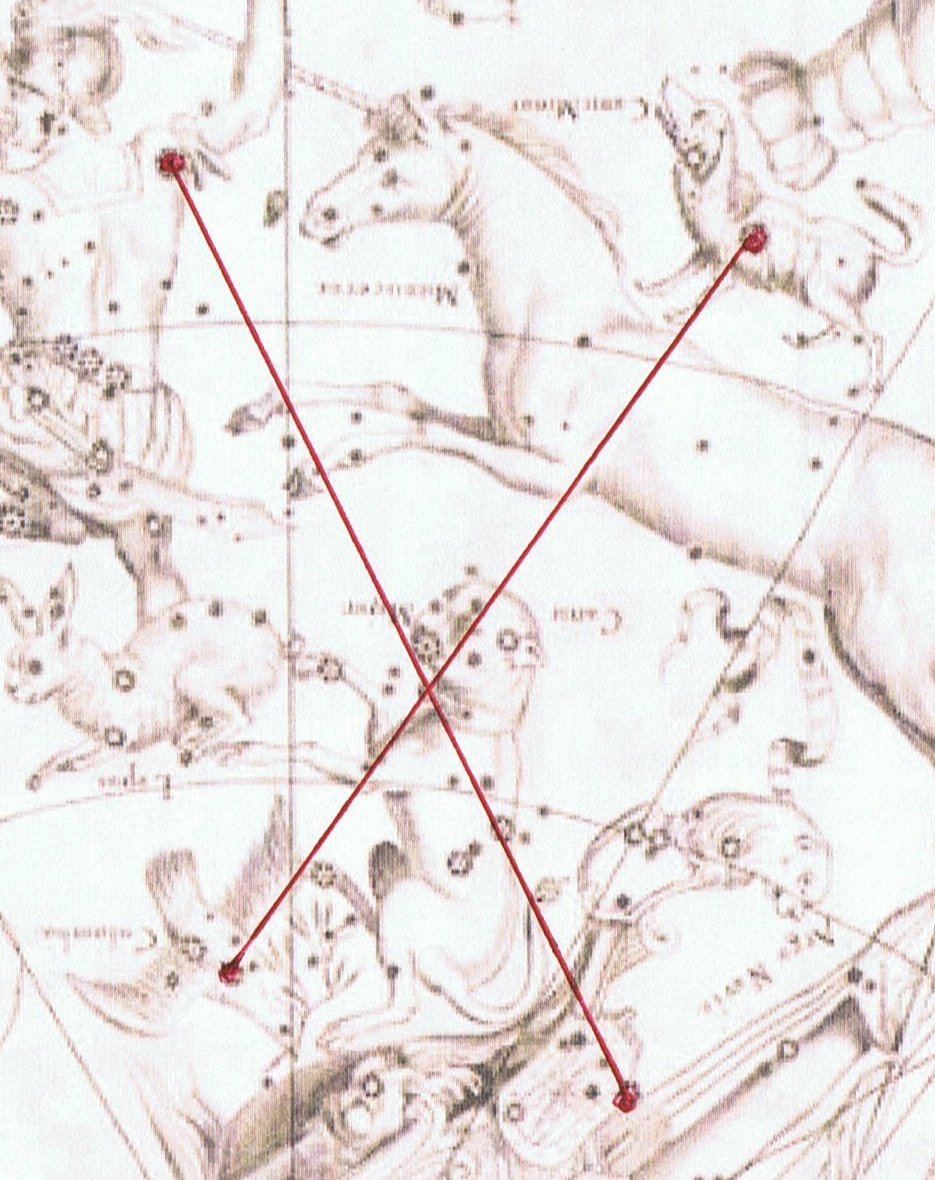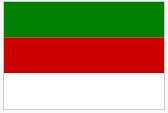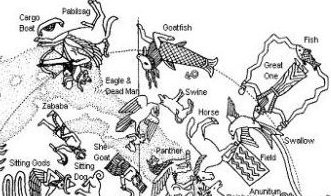58. Botein (δ) was at the Belly of Aries, and according to the G text a new Sun (a new fire in the sky - still faint of course) followed:
The position of maitaki in Gb4-27 was clearly not at a solstice (†) but where a new Sun was born (*). I had to revise my prelimnary guess: ... What then was the basic meaning of maitaki with 3 'eyes' in contrast to maitaki with 2 mata? I guess winter solstice in contrast to spring equinox ... The 3 preceding similar maitaki glyphs on side a of the tablet could then reasonably also have been connected with places of transition (doors of birth and exit), at times when a new cycle necessitated the 'decapitation' of the preceding one (following the birth of the new one).
Looking back to the only 3-eyed maitaki in the C text we can perceive a new Sun and a 'castrated' Old Tree (Rakau). ... The great Canopus rose with the Sun in St John's Day 6 days before Sirius in June 30:
Which means the basic meaning also here probably could have been to describe a change of rulers, indeed quite evident from the Egyptian X depicted in Ca5-14.
Egypt was a special case, because their year began when the waters of the Nile ran down from the mountains in the south to inundate the land in the north:
... In late September or early October 130, Hadrian and his entourage, among them Antinous, assembled at Heliopolis to set sail upstream as part of a flotilla along the River Nile. The retinue included officials, the Prefect, army and naval commanders, as well as literary and scholarly figures. Possibly also joining them was Lucius Ceionius Commodus, a young aristocrat whom Antinous might have deemed a rival to Hadrian's affections. On their journey up the Nile, they stopped at Hermopolis Magna, the primary shrine to the god Thoth. It was shortly after this, in October [in the year A.D.] 130 - around the time of the festival of Osiris - that Antinous fell into the river and died, probably from drowning. Hadrian publicly announced his death, with gossip soon spreading throughout the Empire that Antinous had been intentionally killed. The nature of Antinous's death remains a mystery to this day, and it is possible that Hadrian himself never knew; however, various hypotheses have been put forward. One possibility is that he was murdered by a conspiracy at court. However, Lambert asserted that this was unlikely because it lacked any supporting historical evidence, and because Antinous himself seemingly exerted little influence over Hadrian, thus meaning that an assassination served little purpose. Another suggestion is that Antinous had died during a voluntary castration as part of an attempt to retain his youth and thus his sexual appeal to Hadrian. However, this is improbable because Hadrian deemed both castration and circumcision to be abominations and as Antinous was aged between 18 and 20 at the time of death, any such operation would have been ineffective. A third possibility is that the death was accidental, perhaps if Antinous was intoxicated. However, in the surviving evidence Hadrian does not describe the death as being an accident; Lambert thought that this was suspicious. Another possibility is that Antinous represented a voluntary human sacrifice. Our earliest surviving evidence for this comes from the writings of Dio Cassius, 80 years after the event, although it would later be repeated in many subsequent sources. In the second century Roman Empire, a belief that the death of one could rejuvenate the health of another was widespread, and Hadrian had been ill for many years; in this scenario, Antinous could have sacrificed himself in the belief that Hadrian would have recovered. Alternately, in Egyptian tradition it was held that sacrifices of boys to the Nile, particularly at the time of the October Osiris festival, would ensure that the River would flood to its full capacity and thus fertilize the valley; this was made all the more urgent as the Nile's floods had been insufficient for full agricultural production in both 129 and 130. In this situation, Hadrian might not have revealed the cause of Antinous's death because he did not wish to appear either physically or politically weak. Conversely, opposing this possibility is the fact that Hadrian disliked human sacrifice and had strengthened laws against it in the Empire ...
... The Heligoland flag is very similar to its Coat of arms. A tricolour flag with three horizontal bars, from top to bottom: Green, Red and White.
Each of the colours has its symbolic meaning. Green symbolises the land, red symbolises the edge (the red cliffs of Heligoland) and white symbolises the sand. This in German is the motto of Heligoland [Holy Land]:
Grün ist das Land, In English, 'Green is the Land, Red is the Brim, White is the Sand, These are the Colours Of Heligoland'. In the original Low German it says, Green is dat Land, roat is de Kant, witt est de Sunn, dat sünd de Farven van't Hilligelunn ...
... He was the son of Baldr and Nanna. His home was Glitnir, its name, meaning shining, referring to the hall's silver ceiling and golden pillars, which radiated light that could be seen from a great distance. Forseti was considered the wisest and most eloquent of gods of Asgard. In contrast to his fellow god Tyr, who presided over the bloody affairs of carnal law, Forseti presided over disputes resolved by mediation. He sat in his hall, dispensing justice to those who sought it, and was said to be able to always provide a solution that all parties considered fair. Like his father Baldr, he was a gentle god and favored peace so all judged by him could live in safety as long as they upheld his sentence. Forseti was so respected that only the most solemn oaths were uttered in his name ... ... Forsite's place of worship was on Heligoland ... destroyed in 785 by Ludger. According to legend, twelve Asegeir or old ones once wandered all over Scandinavia gathering local laws. They wanted to get the best laws from all the tribes and compile them into one set of laws applicable to all of them, thus uniting them in peace. It is said that after gathering laws from all the regions, they embarked on a sea voyage to a remote place where they could safely discuss the process of compilation. However, a vicious storm arose and while at the mercy of sea they invoked the name of Forseti to save them from peril. They noticed that a 13th person appeared in the boat and safely led it to a deserted island. There, the person (presumably Forseti himself) split the earth and a spring was formed. Having consecrated the place he dictated the unified code of laws that merged all the best regulations of various local laws and suddenly vanished. The island became a place of worship to Forsite and the spring was its holy place. All major legal assemblies gathered at the island. The disputes were undertaken in the light of day only, and never in winter as it was believed that darkness was anathema to truth and just resolve ... In the night sky the Milky Way corresponded to the Nile, with Eagle (Aquila) transporting the Dead Man through the air above:
|
|||||||||||||||||||||||||||||||||||||||||||||||||||||||||||||||||||||||||||||||||||||||||||||||||||||||||||||||||||||||||||||||||||||||||||||||||||













